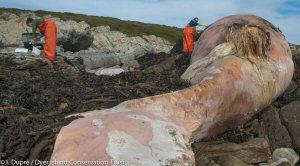Badly decayed sperm whale washed up in Pearly Beach, thousands of miles from home
 In its prime, it would have majestically patrolled the waters as one of the world’s largest creatures. But the badly decayed sperm whale cut a tragic sight, lying washed up on the rocks at Pearly Beach, near Gansbaai. The grim discovery was made by locals who alerted Dyer Island Conservation Trust who have then faced the task of removing the carcass.
In its prime, it would have majestically patrolled the waters as one of the world’s largest creatures. But the badly decayed sperm whale cut a tragic sight, lying washed up on the rocks at Pearly Beach, near Gansbaai. The grim discovery was made by locals who alerted Dyer Island Conservation Trust who have then faced the task of removing the carcass.
Marine biologists are busy conducting tests to determine the cause of death of the male sperm whale (Physeter macrocephalus), which was in a fairly decayed state and had no “obvious signs” that could give a clue regarding the cause of death.
As a deep water whale found in most of the world's ocean, they are not often seen close to shore, so this carcass provides a rare opportunity for scientific sampling which is what the Marine Dynamics / Dyer Island Conservation Trust (DICT) team arranged.
“This is the third sperm whale that has washed up in the Gansbaai area in the last four years which is amazing because we don’t know where they come from. We have DNA samples of all three and will have it analysed and see what further information we can find out,” says Wilfred Chivell of DICT.
 During the days of commercial whaling, sperm whales were caught off South Africa’s east and west coasts.
During the days of commercial whaling, sperm whales were caught off South Africa’s east and west coasts.
Whale beachings can rarely be explained. Scientists attribute them to natural and environmental factors such as rough weather, weakness due to old age, hunting too close to shore and navigation errors.
Sperm whales are deep-sea mammals that tend to live and hunt at a depth of around 3,000m. While females and their young stick to the tropics, males range further afield and are regularly spotted around the polar caps.
Sperm whales rely on sonar to navigate. They send out sound pulses, which bounce back off distant surfaces, helping them to form a clear picture of their underwater world. This doesn't work on a shallow sandy sea bed and whales quickly become disorientated. The sperm whale is one of the deepest diving mammals in the world, the largest of the toothed whales, and the largest toothed predator. Typically it makes dives of up to 400 m but can reach depths of up to 2-3km. It is thought to be able to hold its breath for up to two hours, although 45 minutes is the average dive time. It can measure up to 20 metres (67 feet) long and weigh over 50 tonnes.
 The whales got their name due to the fact that when the head was cut open it was found to contain a milky white substance, leading the whalers to believe the large square head was a huge reservoir for sperm.
The whales got their name due to the fact that when the head was cut open it was found to contain a milky white substance, leading the whalers to believe the large square head was a huge reservoir for sperm.
It is, in fact, spermaceti oil, thought to help in buoyancy control when diving and acts as an acoustic lens. Additionally, an intestinal secretion called ambergris is found in sperm whales which are used in the perfume industry.
Source: Dyer Island Conservation Trust.
Call us and schedule your listing today! Contact Us
Copyright © 2025 Hermanus Online Magazine. Web Development by Jaydee media.

